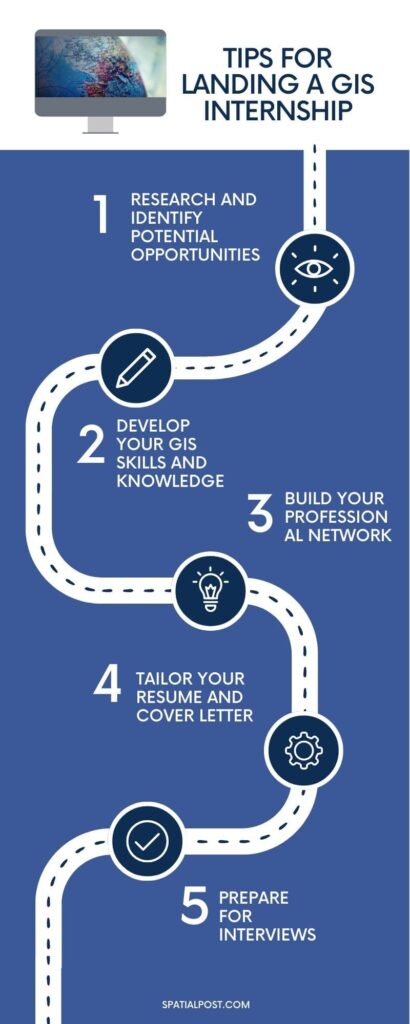Are you a student or recent graduate looking for an internship in Geographic Information Systems (GIS)? GIS internships are a great way to gain valuable experience in a rapidly growing field, and they can provide a pathway to a successful career. However, landing a GIS internship can be challenging, especially if you don’t know where to start. In this guide, we’ll provide you with tips and tricks to help you land the GIS internship of your dreams.
What Is GIS?
Before we dive into tips and tricks for landing GIS internships, let’s first define GIS.
GIS allows us to visualize, interpret, and understand patterns and relationships in data that have a geographic component. GIS is used in a variety of industries, including urban planning, natural resource management, public health, transportation, and more.
What Is GIS Internship?
A GIS internship is an opportunity for students or recent graduates to gain practical experience in the field of Geographic Information Systems (GIS). GIS internships typically involve working with real-world data, software, and tools to collect, manage, analyze, and visualize spatial data.
Interns may work for companies that offer GIS services or products, government agencies, or nonprofit organizations.
Why Pursue a GIS Internship?
GIS internships are an excellent way to gain hands-on experience in the field and develop skills that will be valuable in your future career. Internships provide an opportunity to work with real-world data, software, and tools, and to learn from experienced professionals. Additionally, internships can help you build your professional network, which can be crucial when seeking full-time employment.
Why Are GIS Internships Important?
GIS internships provide students with the opportunity to gain hands-on experience in using GIS technology. This experience helps students develop GIS Skills that are highly sought after in the job market. Internships also allow students to explore various GIS career paths and network with professionals in the field.
Where To Find GIS Internships
It’s important to keep in mind that the availability of GIS internships may vary depending on your location and the time of year. It may also be helpful to network with professionals in the field and attend GIS-related events or conferences to learn about potential internship opportunities. There are many places to find GIS internships. Here are a few options:
- Online Job Boards: Check out job boards such as Indeed, Glassdoor, and LinkedIn for GIS internships.
- Company Websites: Many companies that offer GIS services and products have internship programs. Check their websites for opportunities.
- Government Agencies: Federal, state, and local government agencies often offer GIS internships. Check their websites or contact them directly for more information.
- Professional Associations: Professional associations such as the Urban and Regional Information Systems Association (URISA) and the Geographic Information Science and Systems Specialty Group (GISS) often have internship listings on their websites.
- University Career Centers: Many universities have career centers that can help you find internships, including GIS internships.
Tips for Landing a GIS Internship
Here are some of the tips & tricks, you need to follow for GIS Internship:

1. Start Early
The first tip for landing a GIS internship is to start early. Internship opportunities are highly competitive, so it’s essential to start looking for opportunities well in advance. It’s not uncommon for students to begin their search six months to a year before they plan to start their internship.
2. Research Potential Employers
Researching potential employers is crucial when looking for a GIS internship. Make a list of companies or organizations that interest you and find out what kind of GIS projects they are working on. This will help you tailor your resume and cover letter to the specific needs of each potential employer.
3. Develop Strong Communication Skills
Strong communication skills are essential when working in GIS. As an intern, you will be working with a team of professionals, and it’s important to be able to communicate effectively with them. Take courses or attend workshops that will help you improve your written and verbal communication skills.
4. Build a Strong Resume and Cover Letter
Your resume and cover letter are your first opportunity to make a good impression on potential employers. Make sure your resume and cover letter are well-written, highlight your skills and experience, and demonstrate your enthusiasm for GIS.
5. Build Your GIS Skills
Building your GIS skills is crucial when looking for a GIS internship. Take GIS courses or attend workshops that will help you develop your skills. It’s also a good idea to work on GIS projects outside of class to build a portfolio of work that demonstrates your skills and experience.
6. Network
Networking is essential when looking for a GIS internship. Attend GIS conferences, job fairs, and other events where you can meet professionals in the field. Join GIS-related groups on LinkedIn or other social media platforms to connect with other professionals.
7. Be Prepared for Interviews
Once you’ve landed an interview, it’s essential to be prepared. Research the company or organization and be prepared to discuss how your skills and experience align with their needs. Practice answering common interview questions and be prepared to ask questions of your own.
Preparing for a GIS Internship Interview
Here are some tips for preparing for your interview:
- Research the Company: Learn as much as you can about the company you’ll be interviewing with. Visit their website, read their mission statement, and learn about their products or services.
- Review Your Resume: Make sure you’re familiar with the details of your resume, as you may be asked about your experience or skills.
- Practice Your Interview Skills: Practice answering common interview questions, and consider doing a mock interview with a friend or mentor.
- Prepare Questions to Ask: Have a few questions prepared to ask the interviewer about the company, the internship, or the work you’ll be doing.
8. Follow Up
After an interview, follow up with a thank-you note or email. This will help keep you top of mind with potential employers and demonstrate your interest in the internship.
What To Expect During a GIS Internship
Every GIS internship will be different, but here are some common tasks and responsibilities you can expect:
Data Collection and Management
As a GIS intern, you may be responsible for collecting and managing spatial data for the company or organization you’re interning with. This could include gathering data from various sources, inputting data into GIS software, and ensuring the accuracy of the data.
Map Creation
You may be tasked with creating maps using GIS software. This could include creating thematic maps, topographic maps, or 3D maps.
Spatial Analysis
You may be asked to conduct spatial analysis on data, such as identifying patterns or trends. This could include using GIS software to perform spatial queries, creating buffers, or conducting proximity analysis.
Collaboration
You’ll likely be working with other GIS professionals and may collaborate on projects with other departments or teams. This could involve working with engineers, planners, or environmental scientists.
Learning Opportunities
A GIS internship is an excellent opportunity to learn from experienced professionals in the field, gain exposure to new software and technologies, and attend training or workshops. You may also have the opportunity to attend conferences or participate in webinars to enhance your knowledge and skills in GIS.
Conclusion
Landing a GIS internship can be challenging, but with the right preparation and approach, you can increase your chances of success. Start early, research potential employers, build your GIS skills, network, and be prepared for interviews. Apply to multiple internships, be flexible, consider virtual internships, seek guidance from your professors, and don’t be afraid to volunteer.
FAQs: Ultimate Guide To Landing GIS Internships
How do I know if a GIS internship is right for me?
If you have an interest in geography and enjoy working with spatial data, a GIS internship may be a good fit for you.
Can I get a GIS internship without prior experience?
Yes, it’s possible to get a GIS internship without prior experience, but it’s essential to build your GIS skills and have a strong resume and cover letter.
What kind of GIS projects do employers look for in interns?
Employers look for interns who have experience working on GIS projects that are relevant to their organization. Research potential employers and tailor your resume and cover letter to their specific needs.
How can I stand out during a GIS internship interview?
To stand out during a GIS internship interview, be prepared to discuss how your skills and experience align with the employer’s needs, and ask thoughtful questions about the internship and the organization.
What are some common GIS internship roles?
Some common GIS internship roles include GIS analyst, GIS technician, GIS developer, and GIS specialist.
